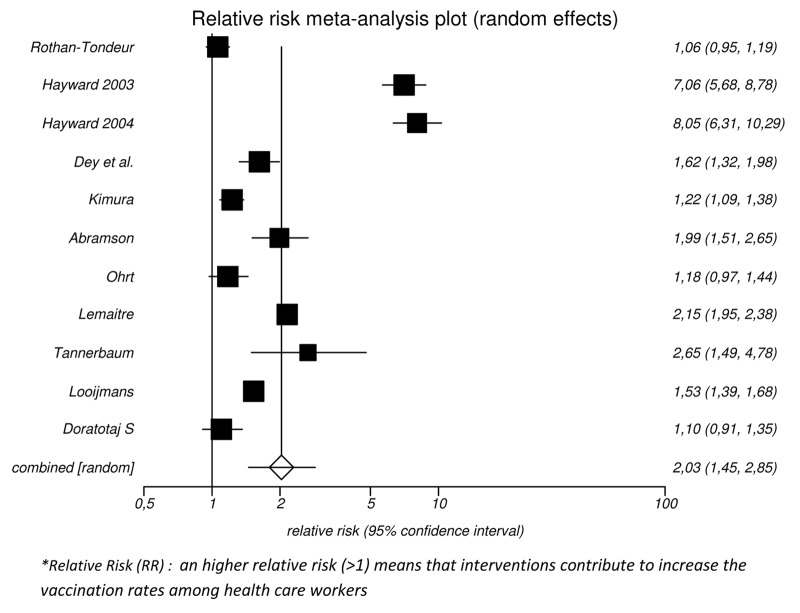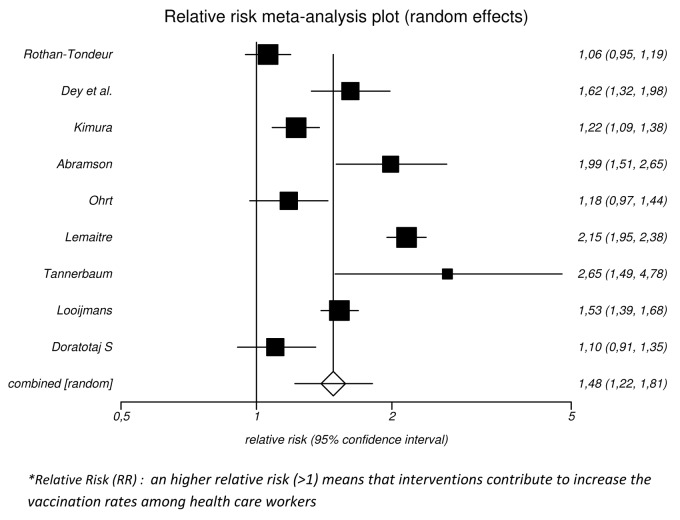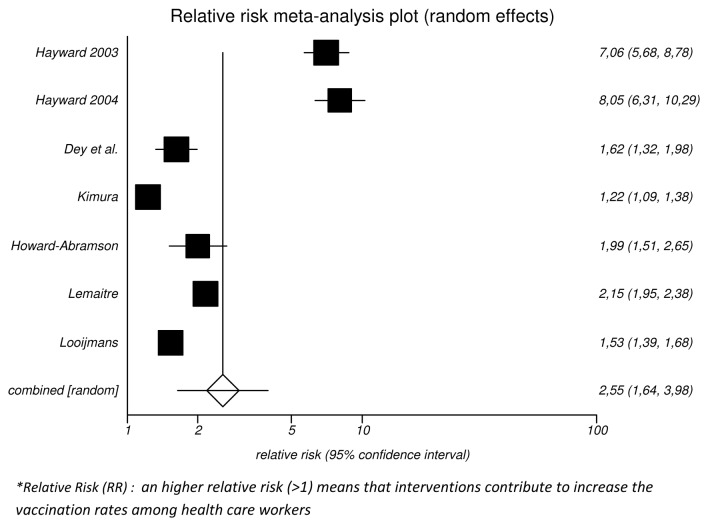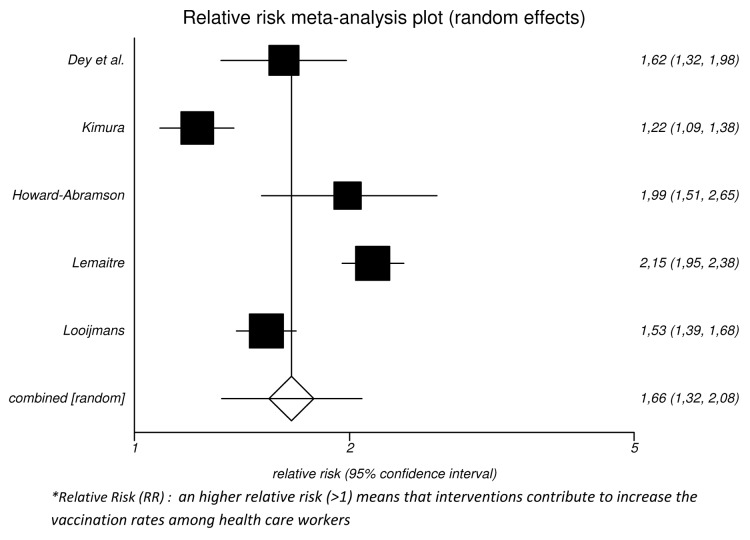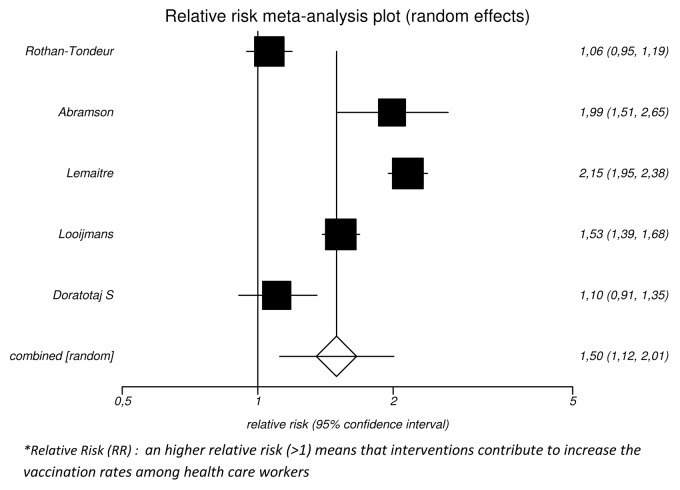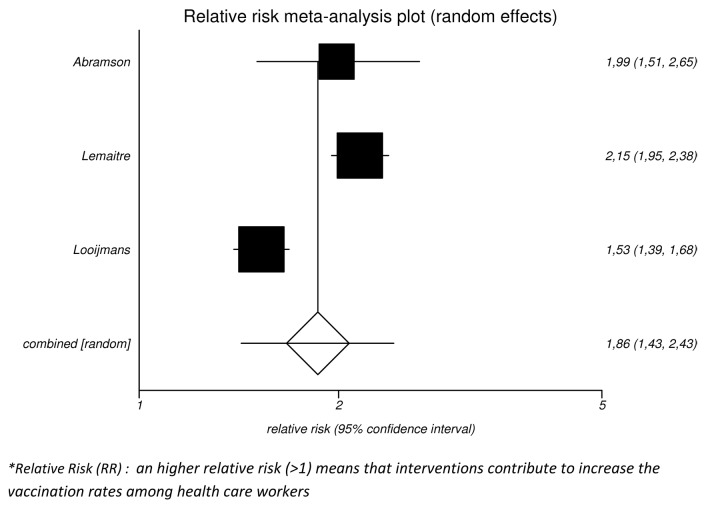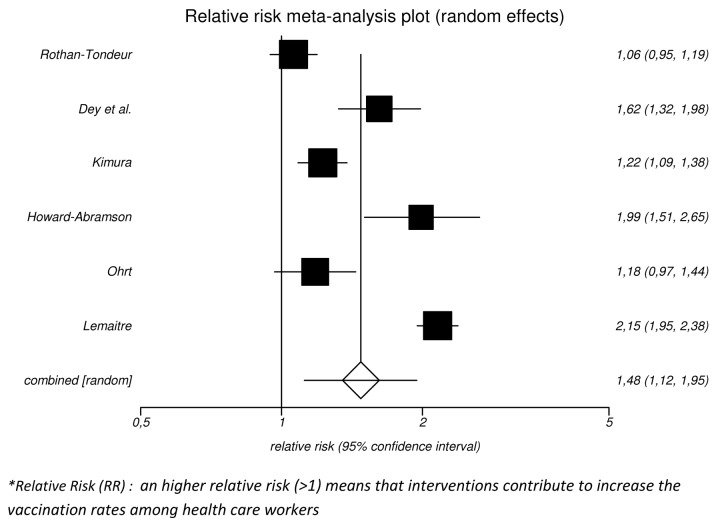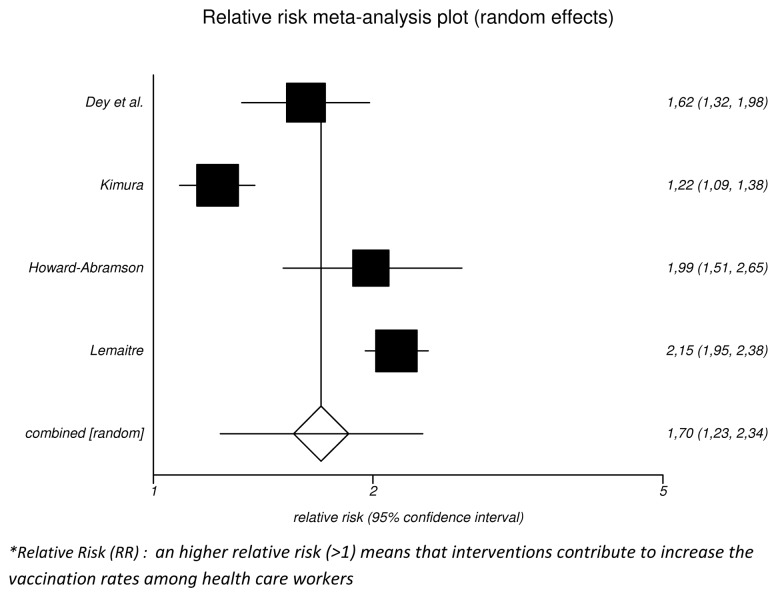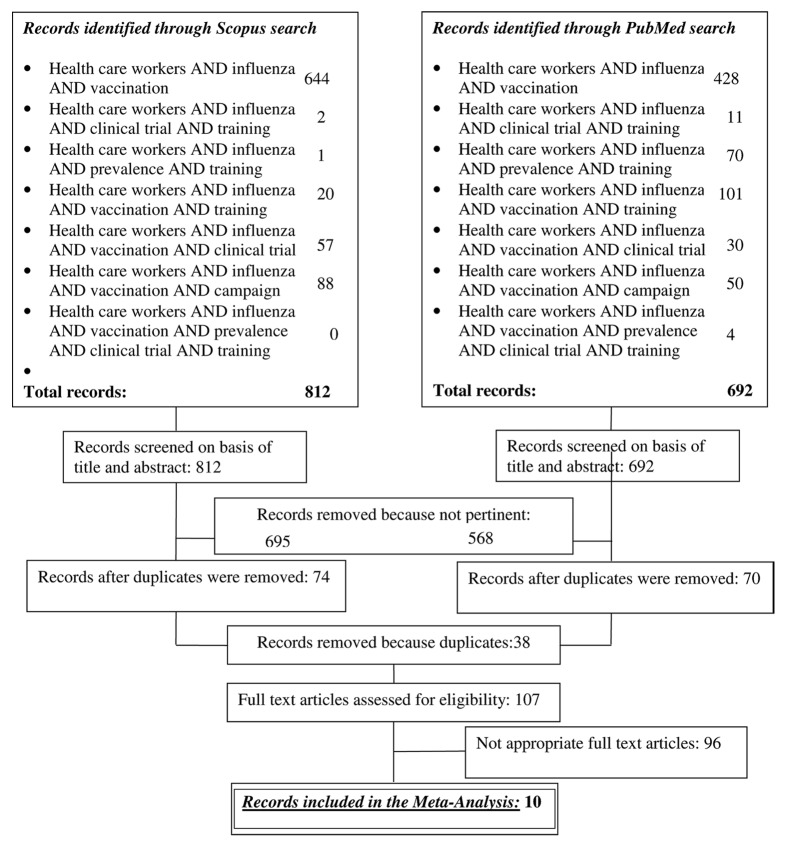Abstract
Introduction: Despite longstanding recommendations by public-health authorities vaccination coverage in health care workers worldwide are poor. The aim of this study is to conduct a systematic review of the trials conducted to increase seasonal influenza vaccination rates among health care workers.
Results: Ten articles met the pre-determined criteria. For all article the score calculation was performed.
Discussion: The combination of an educational and a promotional element appared the most effective in augmenting the influenza vaccination coverage among health care workers. But some cases, the intervention did not contribute to increasing the vaccination rates among health care workers. In any case, the quality of controlled trials plays an important role in the results obtained by carrying out a specific intervention and contributed to obtaining this debatable results.
Materials and Methods: Research was conducted using Scopus and PubMed database. We selected all clinical trials to perform the meta-analyses.
Keywords: influenza, vaccination, health care workers, clinical trials, systematic review
Introduction
The most efficient means of preventing a significant number of influenza infections, and the resulting morbidity and mortality, is an annual pre-exposure vaccination. Simply staying home from work when manifestly ill is not effective as a strategy to prevent transmission.1 (Poland et al., 2005) as the virus may be shed for at least 1 d prior to symptomatic illness (Bridges et al., 2003, Mc Lennan et al., 2010).2,3
Studies have shown that immunization of health care workers (HCW) protects their patients (Wilde et al., 1999, Hayward et al., 2006, Ito et al., 2006),4-6 from influenza infection. In addition, vaccinating HCW can also reduce influenza-related absenteeism, ensuring the capacity of the healthcare system to meet society needs (Sartor et al., 2002).7
Despite longstanding recommendations by public-health authorities vaccination coverage in health care workers worldwide are very poor, with only about 4–40% coverage rates being achieved (Mc Lennan et al., 2010).3 In Europe rarely exceeds 30% (Blank et al., 2009).8 Rates are particularly low in nursing staff, the HCWs in closest contact with patients (Toronto et al., 2010, La Torre et al., 2011).9,10
As alternative to mandatory approach, that poses many questions on HCW autonomy, several public health organizations and hospitals have embarked in the endeavor entailing the increase of seasonal influenza vaccination rate among HCW by setting up interventions. Previous studies have reported the effectiveness of various campaigns in medical setting. Most were before-after studies, and fewer were randomly controlled (Abramson et al., 2010).11
The interventions have included educating HCWs about the benefits of influenza vaccination, making the vaccine free and easy to obtain for all HCWs, providing feedback of vaccination rates, obtaining a signed declination from HCWs who refuse vaccination, and others (Polgreen et al., 2008).12
The only attempt to assess the effectiveness of interventions had previously been performed by a systematic review of Lam and coworkers (2010).13 They evaluated studies published in 2008 at the latest. However, in their study Lam et al., did not focus the attention on quality evaluation of the studies, in order to assess if quality can affects the results of interventions.
The aim of this study is to conduct a systematic review of the trials conducted to increase seasonal influenza vaccination rates among HCW, to evaluate their effectiveness and the influence of the quality and the year of publication of the studies on the outcomes. This study focuses solely on interventions aimed to increase the seasonal influenza vaccination rate or studies that reported rate before and after an intervention and excludes studies presenting results on pandemic influenza.
Results
Identification of relevant research
In total 1,504 articles were identified in both PubMed and Scopus. Of these, 1,263 were removed because not relevant (lack of intervention, intervention concerning pandemic influenza instead of seasonal influenza, or focus diverging from health care workers). The remaining 259 articles were subjected to a screening of both the title and the abstract in the two search engines separately, and to the removal of duplicates in each database. Subsequently, 70 articles were found in the search engine PubMed and 74 were found in Scopus. The number of articles that were present in both search engines was 38, leaving 106 articles having to be assessed for eligibility. Of these 106 results, 96 were further eliminated because of an unwanted or faulty study design, because no our outcomes or because data was self-reported or missing, or because the full-text was unavailable to the university. Finally, 11 articles met the pre-determined criteria described above. A the end just one was excluded because a letter to editor and although it described the interventions aimed to increase the seasonal influenza vaccination rate including all data, there were many limit in insufficiently reported, being published as a letter
We included in the review the trial performed by Hayward et al., 2006 although the specific context where the trial took place was different from the others.
Quality Assessment
JADAD scale was used in order to assess the quality of the 10 controlled trials.
Of the 10 articles, two investigators independently found that 6 were of good quality, while the remaining 4 were of bad quality. More specifically, 6 articles scored ≥ 32006,5 Dey et al., 2001,14 Kimura et al., 2007, 15Abramson et al., 2010,16 Looijmans-van den Akker et al., 2010,17 Lemaitre 200918, while the studies by Ohrt et al. (1992),19Doratotaj et al. (2008),20 Rothan-Tondeur et al. 2010,21 Tannenbaum et al. 1993,22 were scored < 3. Please refer to Table 1 for an overview of the selected literature.
Table 1. Characteristics of the selected studies (clinical trials).
| Bibliography Rank | Authors and (Citation number) | Year of publication | Study design | Total experimental n. | Vaccinated pre (exp) n. (%) | Vaccinated post (exp) n. (%) | Total control n. | Vaccinated pre n. (%) | Vaccinated post n. (%) | JADAD score 1 (1–5) | JADAD score 2 (1–5) | JADAD score 3 (1–5) definitive |
|---|---|---|---|---|---|---|---|---|---|---|---|---|
| 1 |
Rothan-Tondeur et al.21 |
2010 |
cluster-RCT |
1,201 |
336 (28%) |
408 (34%) |
1144 |
286 (25%) |
366 (32%) |
-1 |
-1 |
-1 |
| 2 |
Hayward et al.**5 |
2006 |
cluster-RCT (2003–2004) |
1,610 |
|
570 (35.4%) |
1674 |
|
84 (5%) |
4 |
3 |
4 (resolving) |
| 2 |
Hayward et al.**5 |
2006 |
cluster-RCT (2004–2005) |
1,726 |
|
527 (30.5%) |
1766 |
|
67 (3.8%) |
|
|
4 (resolving) |
| 3 |
Dey et al.14 |
2001 |
cluster-RCT |
PHCT*: 457 |
|
100 (21.9%) |
PHCT*: 395 |
|
83 (21%) |
4 |
3 |
4 (resolving) |
| |
|
|
|
NH*: 768 |
|
78 (10.2%) |
NH*: 1364 |
|
77 (5.6%) |
|
|
|
| 4 |
Kimura et al.15 |
2007 |
cluster-RCT |
Ed*: 821 |
240 (29%) |
298 (34%) |
1517 |
467 (31%) |
450 (28%) |
4 |
4 |
4 |
| |
|
|
|
(vacc.day) 832 |
292 (35%) |
410 (46%) |
|
|
|
|
|
|
| |
|
|
|
(ed + vacc. Day) 754 |
295 (39%) |
439 (53%) |
|
|
|
|
|
|
| 5 |
Abramson et al.16 |
2010 |
cluster-RCT |
163 |
44 (27%) |
86 (52.8%) |
181 |
36 (19.9%) |
48 (26.5%) |
3 |
4 |
4 (resolving) |
| 6 |
Ohrt et al.19 |
1992 |
cluster-RCT |
180 |
50 |
103 |
175 |
48 |
85 |
2 |
2 |
2 |
| 7 |
Lemaitre et al.18 |
2009 |
cluster- RT |
989 |
198 |
678 |
1015 |
200 |
|
4 |
4 |
4 |
| 8 |
Tannenbaum et al.22 |
1993 |
cluster-CT |
135 |
23 |
35 |
133 |
22 |
13 |
-1 |
-1 |
-1 |
| 9 |
Looijmans I et al.17 |
2009 |
cluster-RT |
Tot. 3,086 (20%) |
|
|
Tot. 3,550 (21%) |
|
|
4 |
4 |
4 |
| (1) All HCWs Vaccinated |
774/3085 (25.1%) |
|
|
582/3,550 (16.4%) |
|
|
|
|||||
| (2) Physician Vaccinated |
43/70 (61.4%) |
|
|
37/75 (49.3%) |
|
|
|
|||||
| (3) Nurses Vaccinated |
94/179 (52.5%) |
|
|
79/287 (27.5%) |
|
|
|
|||||
| (4) Nursing assistants Vaccinated |
429/2095 (20.5%) |
|
|
296/2,138 (13.8%) |
|
|
|
|||||
| 10 | Doratotaj et al.20 | 2008 |
cluster-RT |
200 |
|
tot. 78 (39%) |
200 |
|
tot. 76 (38%) |
1 |
1 |
1 |
| |
|
200 |
|
tot. 84 (42%) |
200 |
|
|
|
|
|
||
| 200 | tot. 89 (44,5%) | 200 |
* PHCT, Pshycians; NH, Nurse; Ed, Educational; **Hayward et al. (2006) The study delineated a pair matched cluster randomized controlled trial during the winters of 2003–4 and 2004–5. We considered the study as two in one and the study have a different and specific context in comparison to the others. ***RCT, randomized controlled trial; CT, controlled trial; RT, randomized trial.
When a study was given a score below 3, it was often because the randomization was not adequately described. Thus, potential bias could arise from such studies, specifically in the case in which randomization was not conducted properly.
Types of interventions
It is of primary importance to increase the rate of influenza vaccination among health care workers. Attempts to succeed in such an endeavor are numerous and of different nature. During the literature search, various types of interventions were encountered, ranging from educational interventions to vaccination campaigns or to more drastic measures such as the obligatory use of masks to all health care workers that were not vaccinated, or the use of mandatory declination forms when refusing vaccination. Of the 10 articles found for this systematic review, 5 made use solely of educational interventions. More specifically, the article by Rothan-Tondeur and coworkers (2010)21 promoted influenza vaccination through a slide-show and leaflets, the study by Hayward et al. (2006)5 made use of nurses promoting vaccination and educational leaflets, the intervention performed in the work by Abramson16 was composed by a lecture session and by e-mails giving a brief overview of the relevant literature, Ohrt et al. (1992)19 used an educational memorandum, and Tannenbaum et al. (1993)22 made use of information sessions and posters. The remaining articles made use not only of educational methods, but also of alternative methods in the attempt of increasing vaccination rates among health care workers. As a matter of fact, the controlled trial performed by Looijmans-van den Akker et al. (2010)17 entailed a multi-faceted intervention composed by posters and leaflets informing health care workers of influenza vaccination, by a plenary one-hour information meeting and by an appointment with a physician promoting vaccination.
In the studies conducted by Kimura et al. (2007)15 and Dey et al. (2001),14 free vaccination was offered to all health care workers, who were informed of this initiative through e-mails and posters. Finally, the studies by Kimura et al. (2007)15 and Doratotaj et al. (2008)20 were composed of three intervention groups. In the former study, in addition to an educational intervention entailing a 10 min video, leaflets, posters and flyers, a vaccination day was set up in which health care workers were given the opportunity to get vaccinated free of charge against influenza. Thus, one intervention group received the educational intervention, the second one was subject to the vaccination day, and the third group had both the educational intervention and the vaccination day. In the latter study, the first group was given an educational letter, the second group had the opportunity to win a 3,000 dollar Caribbean trip for two and the last group received both the letter and the ticket offer.
During the literature search, articles were selected if participants were exclusively health care workers or part of the health care personnel. In most articles, no distinction was made between different health care workers, e.g., physicians and nurses. In contrast, in the study by Dey et al. (2001),14 participants were separated in two groups: those that worked in Primary Health Care Teams (PHCT) and those that worked in Nursing Homes (NH). Also, in the study conducted by Looijmans-van den Akker (2010),17 health care workers were divided into three groups: physicians, nurses and nursing assistants.
Pooleed analysis and Sensitivity analyses
Data extracted from the articles were analyzed with StatsDirect.
Both data from the control group and the intervention group prior to, and following, the intervention were introduced into the program.
The Relative Risk (RR) and 95% Confidence Interval (CI), with its lower and upper limit (LL and UL) were calculated for each article. In our case a higher relative risk means that interventions contribute to increase the vaccination rates among health care workers.
When considering all studies, the vaccination rate almost doubled in the intervention group compared with the control group, the random effect model gave a RR = 2.03 (95%CI: 1.45–2.85) (I2 = 98,1%; Cochran Q = 50,224 (df = 10) p < 0.0001) (Egger bias = 5,768,842 (95% CI = -5,383−16,920) p = 0.272) (see Fig. 2).
Figure 2. Forrest plot of the analysis concerning all the included studies. *Relative Risk (RR): a higher relative risk (> 1) means that interventions contribute to increase the vaccination rates among health care workers.
Then we repeated the pooled analysis of the trials without Hayward et al., 2006 because the results of this trial are clearly “out of range” and are highly dependent on the specific context where the trial took place. So, the random effect model gave a RR = 1.48 (95%CI: 1.22–1.81) (I2 = 93.3%; Cochran Q = 11,883 (df = 8) p < 0.0001) (Egger bias = -0.262048 (95% CI = -8,188−7,664) p = 0.9399) (see Fig. 3).
Figure 3. Forrest plot of the analysis concerning all the included studies without Hayward et al., 2006. *Relative Risk (RR): a higher relative risk (> 1) means that interventions contribute to increase the vaccination rates among health care workers.
When only taking into consideration studies that scored 3 or higher on the JADAD scale2006,5 Dey et al., 2001,14 Kimura et al., 2007,15 Lemaitre et al., 2009,18 Abramson 201016 and Looijmans-van den Akker et al., 201017, the relative risk increased (RR = 2.55; 95%CI: 1.64–4.95) [I2 = 98.4%; Cochran Q = 375.63 (df = 6) p < 0.0001] [Egger bias = 10.93 (92.5% CI = -6.18−28.04) p = 0,1615] (see Fig. 4) meaning that interventions have positive results.
Figure 4. Forrest plot of the analysis concerning only high quality studies for Jadad’s scale (score > 3). *Relative Risk (RR): an higher relative risk (> 1) means that interventions contribute to increase the vaccination rates among health care workers.
In this case too we performed the analysis without Hayward et al., 2006 for the same reasons as previous and results were (RR = 1.66; 95%CI: 1.32–2.08) [I2 = 92.9%; Cochran Q = 56 (df = 4) p < 0.0001] [Egger bias = -1,412,413 (92.5% CI = -15,12944 to 12,304,614) p = 0.8004] (see Fig. 5)
Figure 5. Forrest plot of the analysis concerning only high quality studies for Jadad’s scale (score > 3) without Hayward et al., 2006. *Relative Risk (RR): a higher relative risk (> 1) means that interventions contribute to increase the vaccination rates among health care workers.
This suggests that the inherent quality of controlled trials has an influence in the results obtained by carrying out an intervention and a specific context where the trial took place too.
Considering the median age of publication that resulted 2007, the analysis for studies published after 2007Rothan-Tondeur et al., 2010, Lemaitre et al., 2009,18 Abramson 201016 and Looijmans-van den Akker et al., 201017 and Doratotaj et al., 200820 resulted: pooled RR = 1,50 (95%CI: 1.12–2.01) [I2 = 95.9%; Cochran Q = 97,554 (df = 4) p < 0,0001] [Egger bias = -2,328,521 (95% CI = -25,434,346 to 20,777,304) p = 0.7695] (see Fig. 6).
Figure 6. Forrest plot of the analysis concerning only studies published after 2007. *Relative Risk (RR): a higher relative risk (> 1) means that interventions contribute to increase the vaccination rates among health care workers.
In addition, considering only high quality studies published after 20072009,18 Abramson 201016 and Looijmans-van den Akker et al., 201017—so excluding from the previous analysis Rothan-Tondeur et al., 2010 and Doratotaj et al., 200820—a pooled RR = 1.86 (95%CI: 1.43–2.43) [I2 = 91,8%; Cochran Q = 24,380 (df = 2) p < 0.0001] (see Fig. 7), suggesting in this case too that the inherent quality of controlled trials has an influence in the results obtained by carrying out an intervention although is in a little difference.
Figure 7. Forrest plot of the analysis concerning only studies published after 2007 and with high quality score to Jadad’s scale (> 3 score). *Relative Risk (RR): an higher relative risk (> 1) means that interventions contribute to increase the vaccination rates among health care workers.
For studies published before 2007—without Hayward et al., 2006: pooled RR = 1.42 (95% CI: 1.14–1.76) [I2 = 75.9%; Cochran Q = 12,446 (df = 3) p = 0.006] [Egger bias = 3,492,152 (92.5% CI = -3,193,986 to 1,017,829) p = 0.214].
Considering on the base of study design the only cluster- RCT—without Hayward et al., 20065—resulted: a pooled RR = 1.48 (95%CI: 1.12– 1.95) [I2 = 95.3%; Cochran Q = 106,300 (df = 5) p < 0.0001] [Egger bias = 0.990986 (95% CI = -18,651−16,669) p = 0.8837] (Fig. 8) and stratified for only high quality ones (> 3 Jadad’s score) we obtained: a pooled RR = 1.70 (95%CI: 1.23–2.34) [I2 = 94.3%; Cochran Q = 12.80 (df = 3) p < 0,0001] [Egger bias = -1,010,601 (95% CI = -31,393,718 to 29,372,516) p = 0.8993] (Fig. 9).
Figure 8. Forrest plot of the analysis concerning only Cluster-RCT studies—without Hayward et al., 2006—and with high quality score to Jadad’s scale (> 3 score). *Relative Risk (RR): a higher relative risk (> 1) means that interventions contribute to increase the vaccination rates among health care workers.
Figure 9. Forrest plot of the analysis concerning only Cluster-RCT studies—without Hayward et al., 2006—and with high quality score to Jadad’s scale (> 3 score). *Relative Risk (RR): a higher relative risk (> 1) means that interventions contribute to increase the vaccination rates among health care workers.
Discussion
In this systematic review, we retrieved 10 controlled trials which addressed interventions designed to increase the influenza vaccination coverage among health care workers. The vast majority of the studies used an educational campaign or at least an educational component in the intervention, in the attempt to increase the influenza vaccination rates among health care workers. On the one hand, it emerged that the combination of an educational and a promotional element, such as the vaccination day in the study by Kimura et al. (2007),15 were the most effective in augmenting the influenza vaccination coverage among health care workers. On the other hand, in some cases it appeared that the intervention did not contribute to increasing the vaccination rates among health care workers as reported by Dey et al.14
In any case, this systematic review asserted that the quality of controlled trials plays a role in the results obtained by carrying out a specific intervention. As a matter of fact, when only including studies that scored 3 or higher in the JADAD scale, the relative risk was equal to 2.55 (1.64–4.95), while it was 2.03 (1.45–2.85) when including all studies. But it’s true that the context were the intervention is made is important too as for Haward in which the study was performed in a large private chain of UK care homes and the outcome of the study was not the effectiveness of interventions (they adopted a policy for influenza vaccination of staff in randomly selected intervention homes while maintaining their usual policy of not actively promoting staff vaccination in control homes) but the effect of vaccinating care home staff against influenza on mortality, health service use, and influenza like illness among residents. In fact when we excluded Hayward et al., 2006,5 the RR (the efficacy of intervention in prevalence of post vaccination compared with pre vaccination) was from 1.54 (1.25–1.90) for all other studies included in the review to a little higher value of 1.66 (1.32–2.05) for studies that scored 3 or higher in the JADAD scale.
The limitations of this study include that a risk of bias might have risen through the combination of different interventions, e.g., free vaccination and educational interventions. Also, the insertion of studies that were reviewed as being of bad quality might introduce a form of bias as it is probable that the randomization in these studies had not been performed properly. However, we hope that this risk of bias was limited, as we conducted two analyses: one including these articles and the other one which only considered articles of good quality.
The strength of this systematic review is that the current scientific literature was extensively searched through two databases with seven combinations of keywords. Moreover, PRISMA criteria were applied in every section of the article, thus providing the reader with a transparent reporting of the data.
The influenza vaccination of health care workers can be considered as a new challenge for public health professionals, as inadequate influenza vaccination coverage leads to increased morbidity and mortality in patients, and health care workers and their families.
Our hope is that this study will be a helpful tool for hospitals and other health care facilities that are trying to achieve higher influenza vaccination coverage among their personnel. This systematic review provides facilities that are undertaking such an attempt with an overview of the data that is available today and with an indication of the effectiveness of some measures compared with others.
Materials and Methods
Identification of relevant studies
Literature review was conducted using two medical databases: Scopus and PubMed. The keywords used were: “health care workers,” “influenza,” “vaccination,” “prevalence,” “clinical trial,” “campaign” and “training.”
We performed searches for: “Health care workers AND influenza AND vaccination;” “Health care workers AND influenza AND clinical trial AND training;” “Health care workers AND influenza AND prevalence AND training;” “Health care workers AND influenza AND vaccination AND training;” “Health care workers AND influenza AND vaccination AND clinical trial;” “Health care workers AND influenza AND vaccination AND campaign;” “Health care workers AND influenza AND vaccination AND prevalence AND clinical trial AND training.” Search criteria are summarized in Figure 1.
Figure 1. Flow-chart of search criteria of the systematic review.
The selection was limited to articles published in English, Italian and French and we did not apply any date restrictions. We selected for our analysis all studies evaluating influenza vaccination campaigns for health care personnel. We defined such campaigns as organized efforts to promote greater vaccination coverage among staff members.
After, only trials studies were included and the selection was performed according to the PRISMA criteria (Fig. 1).23
Articles were examined and were excluded if:1 they researched pandemic instead of seasonal influenza;2 studies were not pertaining seasonal influenza interventions and3 if the full text was not available.
We included only trials focused on interventions aimed to increase the seasonal influenza vaccination rates among HCW. In the specific case of trials with before-after research designs, article was excluded if it did not report influenza vaccination rates prior to the year of intervention. This led to a strict selection of the results.
When Medline outcomes overlapped, therefore all duplicate articles were removed. Then the eligible papers were obtained the full text. This literature review was completed in June 2012.
Quality assessment and data extraction
The methodological quality of randomized controlled trials (RCTs) is commonly evaluated in order to assess the risk of bias. JADAD scale was used in order to assess the quality of the controlled trials. The Jadad system consists of three topics (description of randomization, of blinding, of withdrawals and drop outs) that are directly related to reducing bias. The possible answers to all the three questions are yes/no. There are five possible points for its quality score: three single points for yes responses and two additional points for appropriate methods of randomization and ensuring blindness of allocation. The maximal score given in this scale being 5, a study is declared of good quality when the score assigned to it is equal or greater than 3 and of bad quality when the score is below 3.
The studies were reviewed independently by two different researchers to assess their quality, (Table 1) according to the JADAD scale, ranging from 0 (poor) to 5 (rigorous).24 Discrepancies about quality were recorded and solved by a third researcher (Table1).
To perform the meta-analysis we extracted data. The same two reviewers used a data collection form to independently abstract data from the studies. The information extracted were: author, year, study design, population types involved in the study (HCW) and responders, prevalence, intervention assessed designed to increase the uptake of seasonal influenza vaccines among health care workers, vaccinated pre and post intervention (when data was available) and control group.
The reviewers discussed any discrepancies in their results to reach agreement. The characteristics of each study are shown in Table 1 and Table 2.
Table 2. Characteristics of Interventions of the included studies.
| Bibliography Rank | Authors and (Citation number) | Study design | Total experimental n. | Intervention |
|---|---|---|---|---|
| 1 |
Rothan-Tondeur et al. 21 2010 |
cluster-RCT |
1,201 |
PARTICIPANTS:geriatric wards were randomly assigned to two clusters. INTERVENTION: The program cluster (24 wards; 1,918 HCWs) received the active program whereas no action was taken in the control cluster (19 wards; 1,728 HCWs). The program was educational; its objective was to convince HCWs to be vaccinated by giving them top-down scientific information and developing a sense of altruism. Data from HCWs from the program cluster and HCWs from the control cluster were collected. Educational: Give information about flu through slideshow, leaflets and a guide. |
| 2 |
Hayward et al.** 5 2006 |
cluster-RCT(2003–2004) |
1,610 |
PARTICIPANTS:Nursing home staff) and residents care homes intervention homes and matched control homes). INTERVENTION: Vaccination offered to staff in intervention homes but not in control homes. Educational: Nurse promoting and leaflets. |
| 2 |
Hayward et al., **5 2006 |
cluster-RCT (2004–2005) |
1,726 |
PARTICIPANTS:Nursing home staff) and residents care homes intervention homes and matched control homes). INTERVENTION: Free vaccination communicated by letter in which benefits were elencated and posters. |
| 3 |
Dey et al. 14 |
cluster-RCT |
PHCT*: 457 |
PARTICIPANTS:All HCW in primary health care teams(PHCT) and nursing home (NH) in Bury and Rochdale Health Authority were offered free vaccination from their general practitioner. INTERVENTION: Free- vaccination communicated by letter in which benefits were elencated and posters |
| |
|
|
NH*: 768 |
INTERVENTION: Free vaccination communicated by letter in which benefits were elencated and posters |
| 4 |
Kimura et al. 15 2007 |
cluster-RCT |
Ed*: 821 |
PARTICIPANTS: Health care workers at LTCFs were surveyed regarding their knowledge and attitudes about influenza and the influenza vaccine. Results were used to develop 2 interventions, an educational campaign and Vaccine Day (a well-publicized day for free influenza vaccination of all employees at the worksite). Seventy facilities were recruited to participate in an intervention trial and randomly assigned to 4 study groups. INTERVENTION: Educational:10 min video, brochures, flyers and posters. |
| |
|
|
(vacc.day) 832 |
INTERVENTION: Vaccine day:a well-publicized day in which free vaccination is offered. |
| |
|
|
(ed + vacc. Day) 754 |
INTERVENTION: Educational 10 min video, brochures, flyers, posters and Vaccine day (a well-publicized day in which free vaccination is offered). |
| 5 |
Abramson et al.16 2010 |
cluster-RCT |
163 |
PARTICIPANTS: Primary care clinics with direct patient contact (physicians, nurses, pharmacists, and administrative and ancillary staff). Thirteen clinics were randomly selected for an intervention that consisted of a lecture session given by a family physician, e-mail-distributed literature and reminders, and a key figure from the local staff who personally approached each staff member. INTERVENTION: Educational:lecture session, e-mail distributed literature and reminders |
| 6 |
Ohrt et al.19 1992 |
cluster-RCT |
180 |
PARTICIPANTS: Four hundred 42 internal medicine, obstetricsgynecology, and general surgery residents and junior medical students. INTERVENTION: The four interventions employed were1 an educational memorandum outlining vaccine indications sent to all study group members,2 a personal letter mailed to a random sample of half of the remaining unimmunized persons,3 a telephone call to half of the unimmunized letter recipients, and4 vaccine offered directly to the remaining unimmunized persons in clinics and conferences. In addition, a questionnaire was administered to all persons requesting or offered vaccine - Educational memorandum +letter + telephone call + vaccine offered |
| 7 |
Lemaitre et al. 18 2009 |
Cluster-RT |
989 |
PARTICIPANTS: All persons aged 60 and older residing in the nursing homes. INTERVENTION: A cluster-randomized controlled trial was conducted in which 40 nursing homes matched in pairs were randomly allocated to a vaccination (intervention) arm or a no-intervention control arm. Influenza vaccine was administered to volunteer staff after a face-to-face interview. No intervention took place in control nursing homes. Randomization was centralized and based on a simple computerized random number generator. In the intervention arm, a promotional campaign based on posters, leaflets, and an information meeting with the study team between September 15 and October 31, 2006, first sensitized staff to the benefits of influenza vaccination. The campaign described the potential benefits of influenza vaccination for one’s own protection and that of the residents. Influenza vaccination was further recommended during face-to-face interviews with each member of staff present in the nursing homes between November 6 and December 15, 2006. The study team individually met all administrative staff, technicians, and caregivers to invite them to participate, and volunteers were vaccinated at the end of the interview. During the interview, prior vaccination status and, if appropriate, the reason for nonvaccination were also collected. Promotional campaign based on posters, leaflets, and an information meeting |
| 8 |
Tannenbaum et al.22 1993 |
Cluster- CT |
135 |
PARTICIPANTS:The intervention was performed in a 135-bed nursing home in Montreal INTERVENTION: The intervention program consisted of information session for all staff given by phycians on five different occasion over a one-week-oeriod. Following these sessios, memos providing similar information were distribuited to the staff and posters were placed on each floor in the nursing home. Vaccination clinics were held on three different occasions over the subsequent two weeks; vaccine eas also available on request - Information sessions and posters+informational memos |
| 9 |
Looijmans I et al.17 2009 |
cluster-RT |
Tot. 3,086 (20%) |
PARTICIPANTS:all Dutch nursing homes were sent an invitation letter to participate in this study. Only nursing homes that did not intend to offer routine influenza vaccination to their HCWs were ineligible for the trial. So nursing homes were included into the trial and were randomly allocated to an intervention and a control group by computer, each group consisting of 18 homes. Allocation was balanced on three variables; number of beds (a measure for size), influenza vaccine uptake among HCWs in 2005 and geographical region (northern, eastern, southern or western Netherlands). All intervention homes were visited between September 28th and October 12th to prepare for the trial. We pragmatically defined HCWs as all the nursing home personnel with direct patient contact for more than 1 h a week. INTERVENTION: Multifaceted implementation programs 3 components:1 Educational (posters and leaflets);2 Plenary one-hour information meeting;3 Appointment with physician promoting vaccination |
| 1)all HCWs vaccinated | ||||
| 2)physicians vaccinated | ||||
| 3) nurses vaccinated | ||||
| 4)nursing assistants vaccinated | ||||
| 10 | Doratotaj et al.20 2008 | cluster-RT | 200+200+200 | PARTICIPANTS: Eligible study participants consisted of 6723 physicians and nurses with predominantly direct patient contact at an urban tertiary care hospital. INTERVENTION: The study investigated a novel approach for improving influenza vaccination rates among HCW. Eight hundred employees we selected, 200 each from the following 4 categories: professional staff, resident physicians, registered nurses, and li censed practical nurses. Subjects were randomly assigned to receive1 no intervention,2 a letter explaining the importance of influenza vaccine for HCW,3 a ticket activated with influenza vaccine administration for a raffle of a free Caribbean vacation for 2, or4 both the educational letter and the raffle ticket. We compared the proportion of employees receiving vaccination and participating in the raffle across groups. Educational letter/raffle ticket (win vacation)/Educational letter and raffle ticket/ |
Statistical Analysis
We synthesized the data abstracted from all studies and then stratified them by quality (Table 1). For randomized controlled trials with before-and-after studies with a control group, we used the post-intervention vaccination rates to calculate risk ratios (RR) and 95% confidence intervals (95%CI). We summarized the results in a forest plot. (Fig. 2) The statistical analysis was conducted using StatsDirect 2.7.8 statistical software version.
Pooled analysis
The pooled incidence of influenza vaccination following to intervention among HCW was calculated considering all studies included in the review and after stratifying by high quality ones (score ≥ 3).
The pooled incidences were calculated as the back-transformation of the weighted mean of the transformed incidences,25 using inverse arcsine variance weights for the fixed effects model and DerSimonian-Laird weights for the random effects model.26 Together the pooled RR with relative 95% CI and forest plots were realized. We computed the Cochran chi-square (Cochran Q) test27 to evaluate studies heterogeneity, thus using the random effect model when the test highlighted differences between studies and the fixed effect model when no significant differences were shown.
Funnel plots were used in order to control for the presence of publication bias.28,29 Sensitivity analyses were performed to assess bias, for example publication year, study design, specific context where the trial took place, high quality studies resulting with Jadad scale.
Disclosure of Potential Conflicts of Interest
No potential conflicts of interest were disclosed.
Footnotes
Previously published online: www.landesbioscience.com/journals/vaccines/article/22736
References
- 1.Poland GA, Tosh P, Jacobson RM. Requiring influenza vaccination for health care workers: seven truths we must accept. Vaccine. 2005;23:2251–5. doi: 10.1016/j.vaccine.2005.01.043. [DOI] [PubMed] [Google Scholar]
- 2.Bridges CB, Kuehnert MJ, Hall CB. Transmission of influenza: implications for control in health care settings. Clin Infect Dis. 2003;37:1094–101. doi: 10.1086/378292. [DOI] [PubMed] [Google Scholar]
- 3.McLennan S, Wicker S. Reflections on the influenza vaccination of healthcare workers. Vaccine. 2010;28:8061–4. doi: 10.1016/j.vaccine.2010.10.019. [DOI] [PubMed] [Google Scholar]
- 4.Wilde JA, McMillan JA, Serwint J, Butta J, O’Riordan MA, Steinhoff MC. Effectiveness of influenza vaccine in health care professionals: a randomized trial. JAMA. 1999;281:908–13. doi: 10.1001/jama.281.10.908. [DOI] [PubMed] [Google Scholar]
- 5.Hayward AC, Harling R, Wetten S, Johnson AM, Munro S, Smedley J, et al. Effectiveness of an influenza vaccine programme for care home staff to prevent death, morbidity, and health service use among residents: cluster randomised controlled trial. BMJ. 2006;333:1241. doi: 10.1136/bmj.39010.581354.55. [DOI] [PMC free article] [PubMed] [Google Scholar]
- 6.Ito Y, Sumi H, Kato T. Evaluation of influenza vaccination in health-care workers, using rapid antigen detection test. J Infect Chemother. 2006;12:70–2. doi: 10.1007/s10156-005-0424-9. [DOI] [PubMed] [Google Scholar]
- 7.Sartor C, Zandotti C, Romain F, Jacomo V, Simon S, Atlan-Gepner C, et al. Disruption of services in an internal medicine unit due to a nosocomial influenza outbreak. Infect Control Hosp Epidemiol. 2002;23:615–9. doi: 10.1086/501981. [DOI] [PubMed] [Google Scholar]
- 8.Blank PR, Schwenkglenks M, Szucs TD. Disparities in influenza vaccination coverage rates by target group in five European countries: trends over seven consecutive seasons. Infection. 2009;37:390–400. doi: 10.1007/s15010-009-8467-y. [DOI] [PubMed] [Google Scholar]
- 9.Toronto CE, Mullaney SM. Registered nurses and influenza vaccination. An integrative review. AAOHN J. 2010;58:463–71. doi: 10.3928/08910162-20101027-01. [DOI] [PubMed] [Google Scholar]
- 10.La Torre G, Mannocci A, Ursillo P, Bontempi C, Firenze A, Panico MG, et al. Prevalence of influenza vaccination among nurses and ancillary workers in Italy: systematic review and meta analysis. Hum Vaccin. 2011;7:728–33. doi: 10.4161/hv.7.7.15413. [DOI] [PubMed] [Google Scholar]
- 11.Abramson ZH, Avni O, Levi O, Miskin IN. Randomized trial of a program to increase staff influenza vaccination in primary care clinics. Ann Fam Med. 2010;8:293–8. doi: 10.1370/afm.1132. [DOI] [PMC free article] [PubMed] [Google Scholar]
- 12.Polgreen PM, Chen Y, Beekmann S, Srinivasan A, Neill MA, Gay T, et al. Infectious Diseases Society of America’s Emerging Infections Network. Elements of influenza vaccination programs that predict higher vaccination rates: results of an emerging infections network survey. Clin Infect Dis. 2008;46:14–9. doi: 10.1086/523586. [DOI] [PubMed] [Google Scholar]
- 13.Lam PP, Chambers LW, MacDougall DM, McCarthy AE. Seasonal influenza vaccination campaigns for health care personnel: systematic review. CMAJ. 2010;182:542–8. doi: 10.1503/cmaj.091304. [DOI] [PMC free article] [PubMed] [Google Scholar]
- 14.Dey P, Halder S, Collins S, Benons L, Woodman C. Promoting uptake of influenza vaccination among health care workers: a randomized controlled trial. J Public Health Med. 2001;23:346–8. doi: 10.1093/pubmed/23.4.346. [DOI] [PubMed] [Google Scholar]
- 15.Kimura AC, Nguyen CN, Higa JI, Hurwitz EL, Vugia DJ. The effectiveness of vaccine day and educational interventions on influenza vaccine coverage among health care workers at long-term care facilities. Am J Public Health. 2007;97:684–90. doi: 10.2105/AJPH.2005.082073. [DOI] [PMC free article] [PubMed] [Google Scholar]
- 16.Abramson ZH, Avni O, Levi O, Miskin IN. Randomized trial of a program to increase staff influenza vaccination in primary care clinics. Ann Fam Med. 2010;8:293–8. doi: 10.1370/afm.1132. [DOI] [PMC free article] [PubMed] [Google Scholar]
- 17.Looijmans-van den Akker I, van Delden JJ, Verheij TJ, van der Sande MA, van Essen GA, Riphagen-Dalhuisen J, et al. Effects of a multi-faceted program to increase influenza vaccine uptake among health care workers in nursing homes: A cluster randomised controlled trial. Vaccine. 2010;28:5086–92. doi: 10.1016/j.vaccine.2010.05.003. [DOI] [PubMed] [Google Scholar]
- 18.Lemaitre M, Meret T, Rothan-Tondeur M, Belmin J, Lejonc JL, Luquel L, et al. Effect of influenza vaccination of nursing home staff on mortality of residents: a cluster-randomized trial. J Am Geriatr Soc. 2009;57:1580–6. doi: 10.1111/j.1532-5415.2009.02402.x. [DOI] [PubMed] [Google Scholar]
- 19.Ohrt CK, McKinney WP. Achieving compliance with influenza immunization of medical house staff and students. A randomized controlled trial. JAMA. 1992;267:1377–80. doi: 10.1001/jama.1992.03480100083036. [DOI] [PubMed] [Google Scholar]
- 20.Doratotaj S, Macknin ML, Worley S. A novel approach to improve influenza vaccination rates among health care professionals: a prospective randomized controlled trial. Am J Infect Control. 2008;36:301–3. doi: 10.1016/j.ajic.2007.10.019. [DOI] [PubMed] [Google Scholar]
- 21.Rothan-Tondeur M, Filali-Zegzouti Y, Belmin J, Lejeune B, Golmard JL, de Wazières B, et al. ORIG association Assessment of healthcare worker influenza vaccination program in French geriatric wards: a cluster-randomized controlled trial. Aging Clin Exp Res. 2010;22:450–5. doi: 10.1007/BF03337740. [DOI] [PubMed] [Google Scholar]
- 22.Tannenbaum TN, Thomas D, Baumgarten M, Saintonge F, Rohan I. Evaluation of an influenza vaccination program for nursing home staff. Can J Public Health. 1993;84:60–2. [PubMed] [Google Scholar]
- 23.Liberati A, Altman DG, Tetzlaff J, Mulrow C, Gøtzsche PC, Ioannidis JPA, et al. The PRISMA statement for reporting systematic reviews and meta analyses of studies that evaluate health care interventions: explanation and elaboration. Int J Public Health. 2009;4:94–131. doi: 10.7326/0003-4819-151-4-200908180-00136. [DOI] [PubMed] [Google Scholar]
- 24.Jadad AR, Moore RA, Carroll D, Jenkinson C, Reynolds DJ, Gavaghan DJ, et al. Assessing the quality of reports of randomized clinical trials: is blinding necessary? Control Clin Trials. 1996;17:1–12. doi: 10.1016/0197-2456(95)00134-4. [DOI] [PubMed] [Google Scholar]
- 25.Stuart A, Ord JK. Kendall's Advanced Theory of Statistics (6th edition). London: Edward Arnold 1994. [Google Scholar]
- 26.DerSimonian R, Laird N. Meta-analysis in clinical trials. Control Clin Trials. 1986;7:177–88. doi: 10.1016/0197-2456(86)90046-2. [DOI] [PubMed] [Google Scholar]
- 27.Biotext Camberra. How to review the evidence: systematic identification and review of thescientific literature. Handbook series on preparing clinical practice guidelines. National Health and Medical Research Council Endorsed. 1999 [Google Scholar]
- 28.Higgins JPT, Thompson SG. Quantifying heterogeneity in a meta-analysis. Stat Med. 2002;21:1539–58. doi: 10.1002/sim.1186. [DOI] [PubMed] [Google Scholar]
- 29.Higgins JPT, Thompson SG, Deeks JJ, Altman DG. Measuring inconsistency in meta-analyses. BMJ. 2003;327:557–60. doi: 10.1136/bmj.327.7414.557. [DOI] [PMC free article] [PubMed] [Google Scholar]



